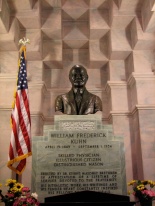Experts tell us that if we want things like bridges, parks, public streets and fire departments, then government must provide them. The private sector either can’t or won’t, or things would simply become awful if it did.
That conclusion is mostly justified by the theory of “public goods,” for which we can thank Paul Samuelson, the first American economist to win a Nobel Prize.
Paul Krugman — another economist and ceaseless supporter of government spending — makes the similar typical claim in this blog post, where he writes that to deny some things must be provided by the government is “stupid,” and to think so you must have slept through Econ 101. By “things the government must provide,” Krugman means everyone being forced to pay via taxation.
Disturbingly, the taxation solution requires many people to foot the bill for things they will never use, or to fund things they oppose. It also means people have less money to do with as they choose. Krugman maintains this is necessary because some things are “public goods whose benefits can’t be internalized by the market.”

A hole punched through a gigantic log at Kauffman Legacy Park; a private, yet free park in Kansas City.
Fortunately, this is one case where “experts” like Krugman are embarrassingly wrong. Yes, we do need fire departments, free education and the like, but the government doesn’t have to pay for them. We will get them, sometimes via the market, and sometimes by different means such as charity and philanthropy. In fact, the aim of this article is to show you just how easy it is to punch holes in claims like Krugman’s — an example of what I will call the “public goods argument.”
Punching holes in the public goods argument is actually an old sport. In the 1960s, Paul Samuelson cited, in a footnote in his textbook Economics, John Stewart Mills’ example of the lighthouse as something that markets could not provide.
This prompted free market economist Ronald Coase to respond with historical documentation of private lighthouses built during the 17th Century in Britain. Since then, people have continued to provide empirical evidence to refute public goods arguments, and cheerleaders for government spending — the Krugmans of the world — have continued to ignore the evidence.
But we’ve got to keep showing them. So, I’ve located several things, right here in Kansas City, that stubbornly exist in contradiction to what experts claim and which serve to undermine the case for public expenditure by Krugman, et al. I’ll drive to each one, and document it with a digital camera. I’ll note how far the thing is from my home, and how long it took me to drive to it.
After seeing how easy it is to find things experts say you won’t, I hope you want to go out and try it yourself.
Exhibit 1: Private Public Street
Cedarbrooke Lane, Cedarbrooke subdivision
South Kansas City
80 ft (2 seconds)
I don’t have to go far before I reach my first destination. At the end of the cul-de-sac, about 80 feet from my garage door, runs Cedarbrooke Lane. This is a privately owned, public street, despite the fact that even most of its owners are probably unaware of the fact. I roll off the gently sloping suburban curb onto a wide expanse of blacktop. Aside from one shallow pothole to the north of me, the street is in good condition and looks comparable to the city-owned Locust Street, which it adjoins. The street is freely accessible to the general public, as well as US Postal and other service vehicles, so it is truly public in the sense that it is available to all who wish to drive on it, yet it is paid for privately.
Such a thing shouldn’t be possible, but here it is.
Apart from their being constructed at all, a big concern about private streets is that they might fall into disrepair because the owners can opt to neglect them when money is short. In the face of such fears, it is interesting that this street has existed for forty years and has always been kept in good condition.
But how? The answer is that it belongs to a homeowners association. When you buy a home in the Cedarbrooke subdivision, you agree to pay dues for the provision of things like trash, water and landscaping, as well as the upkeep of Cedarbrooke Lane. The HOA has a contractual obligation to maintain certain aspects of the member properties. If a particular homeowner fails to pay his or her dues, the HOA is empowered to put a lien on their property to ensure that it can fulfill its obligations.
As a result, not only do the homeowners who together own Cedarbrooke Lane benefit from the street, so does the entire South Kansas City community.
If only the public goods argument were in as good a shape as Cedarbrooke Lane.
Exhibit 2: Private Welfare
Great Temple Mausoleum at Mount Moriah Cemetery
South Kansas City
.25 miles (2 min)
Today it is taken for granted that government must take money from you to make sure someone else doesn’t “slip through the cracks.” Advocates of public social welfare claim that although everyone benefits by not having other people living in squalor, we can’t count on voluntary giving to provide for all who need help. Likewise, they say, private insurance surely won’t cut it because — being profit driven — insurance companies have an incentive not to pay.
Yet this Masonic hall (which spookily, doubles as a mausoleum) is a testament to how, for thousands of years, people have found inventive ways of taking care of one another voluntarily. The Freemasons probably originated as a guild of professional stonemasons in the middle ages. Among other things, guilds provided for the families of member craftsmen in the event of the member’s injury or death. Up until the first part of the 20th Century, such societies in America combined aspects of charity and private insurance: members pooled their resources and the organizations used those funds to help members address hardships.
As David T. Beito describes, these organizations flourished when times were toughest, like during the Great Depression:
The heyday… [of mutual aid societies in America] was during an era when millions of Americans lived on a scale of poverty which would be considered intolerable by today’s underclass. Despite this, millions invested their scarce resources in erecting a vast system of fraternal mutual aid. Although insurance gave some protection, those who subscribed to fraternal societies gained access to services not easily guaranteed in a commercial contract.
Today government programs have crowded out much of what these associations once provided. Yet a friend of mine, who belongs to a lodge, tells me that Freemasons still vow to help fellow lodge members should they lose employment or housing. Next time you are shopping for insurance try asking your new agent if he or she will swear to help you out of the next pickle in which you find yourself!
Just another chink in the armor of the public goods argument.
Exhibit 3: Private and Free Public Park and Botanical Garden
Kauffman Legacy Park & Kauffman Memorial Garden
Midtown Kansas City
11.5 miles (16 min)
Of all public goods, my favorite is the park. What would cities be like without them? But who would want a world where every park, if it existed at all, had a tall fence around it forcing you to pay to get in? What about people who could not afford to pay? These questions call to mind the dismal reality envisioned by the Krugman’s of the world if the government doesn’t provide us with parks.
So I have headed north and soon I’m in my old stomping grounds — Midtown Kansas City. I’m here to put paid to the supposed rule that parks can’t be private and free at the same time.
Amazingly, I find not only a free park, but also a free botanical garden thrown in for good measure. Together Kauffman Legacy Park and Kauffman Memorial Garden span six blocks just east of the wonderful Country Club Plaza shopping district. The park provides outdoor leisure while instilling conservation values by exposing you to the beauty of a native landscape in the heart of a city. Kauffman Memorial Garden is a world-class botanical garden that looks like some medieval nobleman’s courtyard. It’s a favorite for wedding pictures.
Both were built in 2004 along with the Kauffman Foundation Conference Center. They are fast becoming two of the most cherished destinations in KC. Amazingly, all of this goodness costs the Kansas City taxpayer nothing, nor are people charged to use either of the two amenities. The Kauffman Foundation pays for these public amenities the same way it funds educational programs promoting entrepreneurship among disadvantaged youth — via voluntary contributions.
Krugman’s looking tired. Maybe he should take a walk in the park.
Exhibit 4: Private Public Radio
KCUR studios
Midtown Kansas City
7.1 miles (16 minutes)
As usual, as I drive today, I am listening to KCUR – 89.3 FM (Kansas City Public Media). The uniqueness of American public radio is underappreciated by libertarians: Whereas in most Western countries public radio is paid for via some sort of tax, in America, only 16% of its funding comes from government while a huge 39% comes from individual donations. The rest largely comes from charitable foundations and corporate benefactors. With such minuscule public funding, America’s public radio demonstrates that yet another public good arguably refutes what prevailing theory asserts about it.
Libertarians should make a point of contributing to public radio so as to raise the percentage of private funding even higher. We could easily see the day when all funding from taxation could be eliminated with no negative repercussions. By eliminating government involvement, NPR (National Public Radio) would only become more independent — and more secure: While the experts insist that the only way to guarantee the independent voice of public broadcasting to Americans is for government to provide it, according to NPR’s website, individual contributions are the most reliable source of funding in hard times!
Public radio gets my gift of support again this year. Paul Krugman gets a lump of coal.
Exhibit 5: Private Policing
Chesley Brown Security Vehicle
Midtown Kansas City
11.5 miles (16 minutes)
Chances are you feel safer at the grocery store or out on the town in recent years than you previously did. Well it’s not because we have more municipal police on the streets, but rather because we have more private security. Police are one of the standard examples cited as a public good not producible on the market. Yet more and more, police forces are being supplemented by private security officers which can stand guard rather than simply respond after something bad happens — too late to help the victims.
In The Privatization of Police in America, James F. Pastor observes that private police now outnumber municipal police officers by as much as 4:1. Additionally, more support staff are employed, and the annual revenue of private security outstrips that of municipal police, as well:
Private policing has annual revenues over $52 billion with the industry employing 1.5 million people. In contrast, public police spend $30 billion with a workforce of approximately 600,000.
How is this possible? Stores and entertainment districts have an incentive to keep patrons safe as well as to protect their own property. Similarly, homeowners associations can better support property values by providing a safe environment while spreading the cost among the property owners. Just as with the public street I mentioned earlier, it won’t matter that non-residents benefit: if an HOA-contracted security service happens to deter rapists or muggers, thus protecting joggers in the surrounding neighborhood, it won’t cost the HOA any more.
So spill-over effects — what Krugman referred to in his blog post as “benefits not captured by the market” — are not the big problem experts claim they are. It’s a good thing that people who are not the intended objects of protection nevertheless benefit from the deterrence that protective services provide, and it won’t reduce the amount of services employed.
I chance on a good shot of a security vehicle. Judging by its proximity to both The Plaza and the Kauffman properties, I imagine its driver is probably patrolling for one of those organizations. Nevertheless, people who live close by benefit from the deterrence the roaming vehicle provides. Yet that fact has not stopped the client organization from contracting with the security company, despite what public goods theory predicts!
Go to jail, Paul Krugman. (Monopoly reference.)
Exhibit 6: Private Art Museums
Nelson-Atkins Museum of Art
Kemper Museum of Contemporary Art
Midtown Kansas City
11.8 miles (17 minutes)
As with parks, museums are things we’d like folks not to have to pay for since we want as many people as possible to consume the knowledge and culture that such institutions conserve and expound. We want that because it betters our society.
But art is expensive, and so are the museums that house much of it. Cities like St. Louis, Chicago, and New York subsidize the expense so as to allow everyone admission at no cost. Like free parks, free museums fit the description of a public good to a T, because, by their very nature, they are non-excludable making them difficult to pay for.
If the experts are correct, it must be necessary to publicly fund art museums, as the cities listed above do. Except that that’s not what happens in Kansas City, where not just one, but two exceptional museums, not far from each other in KC’s Midtown area, defiantly remain privately owned, but nevertheless, free to the public.
The world renowned Nelson-Atkins Museum of Art has been around for 80 years and never cost the Kansas City citizenry a dime, either in taxes or entry fees.
Likewise, the Kemper Museum of Contemporary Art has not charged for use since its opening in 1994.
These museums — massively expensive as they are — are entirely funded by voluntary contributions: Large sums pledged each year by the well-to-do and corporate sponsors, and small gifts of dollars and loose change contributed by the people who give at the door.
The public goods argument belongs in a museum — a history museum.
Why They Get it Wrong
In some of the cases presented above, the difficulties for the market with regard to public goods was easily overcome — in hindsight.
To paraphrase a response by Richard Dawkins to skeptics of Darwinism, an appeal to your personal incredulity is not a strong argument against the market. The fact that economists sitting behind a desk or scribbling on a whiteboard can’t imagine how the market will get something done has nothing to do with whether it will.
But in the examples I found, it wasn’t always the market that got the job done: sometimes it was just good old civil society — the private sector rather than private enterprise — and always the result of human values, choices, and actions. In either case, government and taxation were not necessary.
As for cases where charity and philanthropy are the vehicles for providing public goods, one reason public goods theorists get it wrong, and assume people won’t do enough, is that they over extend the classical economist’s model of the self-interested rational actor, homo economicus.
That model helped illuminate the actions of the “businessman” as Ludwig von Mises explained; but taken more broadly, it’s a bad caricature of a real human being. Unlike homo economicus, who wouldn’t lift a finger if it wouldn’t increase the value of his bank account, real people donate to help others or to fund a community undertaking they want to see accomplished. When they do, it is because they value others being better off or the success of a project, more than they value the money they contribute to that end.
But in order for people to voluntarily contribute to make society better, they have to have enough left over after other things are paid for. Since taxation reduces people’s expendable income, every government-provided public good reduces people’s ability to help voluntarily.
A Call to Action
Go out and find your own examples of privately provided goodness and punch some more holes in the the public goods argument. It’s fun and all too easy!
Thanks:
Ian Huyett, for introducing me to the concept of mutual aid societies.
Jeffrey Hull, for suggesting I change “Poking” to “Punching” in the title—just to add a little punch.
Erin Skornia, for letting me post photos of her irreverently running in a sprinkler at a cemetery.

“Punching Holes in the Public Goods Argument” by Tracey Zoeller , including all photography and illustrations, is licensed under a Creative Commons Attribution 3.0 Unported License.
“Krugman Able to See at Last” by Tracey Zoeller is based on a photograph by 00Joshi on Flickr at http://www.flickr.com/photos/00joshi/6331682723/.




























































Beautiful piece! Well written and accurate! Thank you for the time and effort you put into showing, in just one city, how free markets can provide what is claimed to be only the domain of the ‘public good’.
Thanks, Nathan! You really “get it.”
Thank you! If I may, I shall attempt to poke a few holes in the “free education must be a government good” argument. Andrew J. Coulson and E. G. West have, in separate tomes, documented how mass education arose in the free market before it was co-opted by governments. In fact, governments originally tried to suppress education; that was one of the purposes of the Stamp Tax.
Nowadays, parents are rediscovering another old custom: home education, which was once the norm in America. About 2 million American children are taught at home, and they are running circles around their government-schooled peers.
Meanwhile, in developing countries where the government is not so strong, James Tooley discovered, documented, and tested thousands of parent-funded free-market un-regulated (or very loosely regulated) schools in the poorest parts of the world. These are usually owned by sole proprietors, although there are larger chains in some cases. They fly under the radar. They’re funded by parents, and run for profit, but they also offer about 10% of their seats for free to those who really can’t afford even a few dollars per month, such as orphans. They’re better, according to standard tests, and provide education at lower costs than comparable government schools.
Thanks, Terry. I want to read the works you list here because I’m very interested in the subject of education in this regard!
You had me up to national progressive radio. Sorry.
Wherein Walter Block critiques even Ronald Coase’s critique of lighthouses as public goods: http://mises.org/media/8000/The-Case-for-Privatizationof-Everything
Great link Henry.
The problem (at least to my knowledge) with private police is that if they are involved in a crime scene, they still have to report to a public police department. In other words, the public police department takes over the case.
When private security are the “last stop,” i.e., they are the ones that make out arrest reports and hold criminal suspects in private jails not overseen by the government and do the CSI and appear in a private court for the prosecution, THEN we will have a real voluntary, private alternative to a government-provided justice system.
Wether it is possible, even in theory, to replace the entire justice system with a private alternative is an open question for me. Let’s focus only on police. You are correct that private security does not yet supply all the functions of municipal police. Yet that does not take away from the surprising rise in the use of private policing to do what is most important, and what our public police do not do well at all—protect us.
1. Cedarbrooke Lane is owned by a cooperative, the neighborhood association, that is *governed* by the board of directors, and the maintenance fees are not voluntary; they are part of the conditions of purchasing a house in tat neighborhood.
2. The Masonic lodge mausoleum is an example of another group-owned facility, *governed* by the lodge officers. Masons have to pay dues in order to remain members in good standing, and in this case the facility is limited for the use of only members and their families.
3. The park is a donation to the public, but the conference center is not free; if you want to hold a conference there, you have to pay to reserve the center.
4. Private public radio? Are you kidding me? Oxymoron much? But seriously, how many public radio stations are operated by government-owned institutions? In this area, 2 out of the 3 public radio stations are.
5. Private security is not a police force; they have no more authority than an ordinary citizen to effect an arrest. And the motive behind it in most commercial implementations is less altruistic than it is in protection of revenue, either directly by reducing theft, or indirectly by making customers feel safe so that they will keep coming to the business to spend money.
6. This is just about the only thing on the list that represents an actual act of altruism. Even so, the Nelson-Atkins is funded by a posthumous foundation, governed by trustees whose money it isn’t, and it’s easy to give when you’re dead. The Kemper is now a 501(c)(3) organization, and thus donations to it are tax-deductible, so it stands to reason that many of its donations are at least partly motivated by the desire to avoid taxes.
You seem pretty hung up on this word “governed.” I don’t imagine that Zoeller has any objections to “governance” as long as it is voluntary.
-“the maintenance fees are not voluntary; they are part of the conditions of purchasing a house in tat neighborhood.” And do you voluntarily choose to move into that neighborhood? This is like saying that paying for a car is not voluntary because paying the dealer is a condition of getting the car.
-“*governed* by the lodge officers.” Who cares? Where did Zoeller object to their being leadership in a voluntary organization?
-“And the motive… is less altruistic” But there’s a magic shield that allows only altruistic people to get into government?
-“This is just about the only thing on the list that represents an actual act of altruism.” Again, I don’t know where Zoeller said that everything he listed is an example of altruism. He clearly says “sometimes via the market” in his introduction.
As Ian correctly stated, I don’t have any problem with rules, so long as they are agreed to voluntary. Libertarians
feelthink that the rules set by the government are not sufficiently easy to opt out of to be called voluntary. Nor are the rules truly opted into. Instead, the rules are set by representatives of the majority of voters (the voters being only a minority with regard to the actual population).With regard to altruism, one of the benefits of the market, is that it orients people toward helping one another in order to help themselves. As a result, in the case of market exchange, we don’t have to rely on altruism.
But I regard the word altruism to be nearly empty of meaning anyway. In ANY action, a person demonstrates (in a certain sense) not altruism, but self interest. So when I give, to the art museum or to public radio, it is not a selfless act but an expression of my values, just as in a market exchange: I want there to be public radio and I pay for it. In the Randian sense, the act can even be called selfish.
You suggest that tax deductions for charitable causes reward people, and so, I imagine you may think, shift part of the responsibility for the giving back to the government.
Remember that getting a tax deduction does not make you richer, it merely reduces the amount by which you will be plundered. If you are lucky, by donating to a charitable cause, you may reduce the amount by which you will be robbed come tax day, but you will not make money by doing so. I fail to see how this makes giving “self interested” in the common sense of that expression.
So what if I expect to become less poor with a tax break than I would expect to become without the benefit of one? You may think me less laudable, but do you really care more about my earning moral points or about my getting public radio paid for?
The tax break should not be seen as a reward, but a discount on a penalty. It exists as a guilty admission on the part of the government that taxation penalizes doing good.
This essay should be appalling to anyone with the slightest shred of common sense or critical thinking.
Exhibit one: a road funded by well-off people in an area that specifically benefits them. If this is the model, anyone who lives in a poor neigbourhood is stuck with a pot-holed mess.
Exhibit two: structured around a straw man argument. I’m pretty sure insurance is a private institution. Meanwhile, the government actually does stick by people in a pickle, through public programs like welfare.
Exhibit three: the existence of philanthropy does not mean it is the rule. Your argument here and throughout this piece (your other exhibits being variants on these three) seems to be that because charity exists, it would fill and exceed the vacuum left by public works funded via taxation. Your article is completely bereft of any evidence to support this claim. To do so, you would need to prove a causal relationship between a decrease or elimination of public funds and an improvement in public works, which, of course, you have not shown because that relationship does not exist and to pretend it exists is ignorant/intentionally misleading.
I would recommend you spend time reading the works I cite or link to in the article. Additionally, try Googling Walter Block or David Friedman in conjunction with the search term “public goods.”
Ah, yes, but why are those people well-off? Because they made a life for themselves. No government required. By the way, I live in a well off neighborhood with publicly funded roads. It is a crime how crappy they are, especially since talking about the “roads” are usually the government yes-man’s last ditch effort to defend his crumbling theory of society. The fact that it is even possible (to say nothing of whether or not it is “the rule”) for the private sector to provide high quality public goods disproves the only decent (but still fatally flawed) argument there ever was for government: that it is necessary. I am afraid once the possibility (no matter how insignificant) exists that it is not necessary for a given set of goals, that the burden of proof shifts even further in the direction of state apologists and propagandists (though, the violence required to create and maintain the state already placed that burden squarely upon them). http://isaacmorehouse.wordpress.com/2013/03/08/but-who-would-bilk-the-roads/
“Apart from their being constructed at all, a big concern about private streets is that they might fall into disrepair because the owners can opt to neglect them when money is short.”
Exhibit 1 only addressed private roads in wealthy areas. In your comment above you express doubt that people with little money could maintain private roads. Do you really think they could work in impoverished areas?
“members pooled their resources and the organizations used those funds to help members address hardships… Freemasons still vow to help fellow lodge members should they lose employment or housing.”
But do they provide care for people who are not members? Welfare in the welfare state is meant to be for everybody, not only for members of a select group.
See my reply to Patrick P.
Are you sure about that?
The Privatization of Roads and Highways
Click to access The%20Privatization%20of%20Roads%20and%20Highways.pdf
The funny thing about many of the suggestions listed in this book is that you don’t need private enterprise to enact them. You could have people pay for only the roads they drive on and the miles they drive on them by tracking their vehicle’s whereabouts via computer chips similar to credit cards, or enlist fines for bad driving habits the same way, and you can do this via government or free enterprise. Of course, that’s horrifying because why in the world would you want to give anyone the power to track your whereabouts on a whim? Why in the world you don’t treat corporations with the same suspicion you do government is beyond me.
I’m also very worried by the unaddressed implications of many of his other solutions. Competing intersecting roadways won’t be an issue because one or the other will own the intersection? That sounds like a nightmare for motorists as the company with intersection ownership can control the flow of traffic to make the competing roadway undesirable. Without government oversight this would lead very quickly to monopolization, where large swaths of interconnected roadways would be owned by a single entity – a scenario Block summarily ignores. So let’s say you live in a neighbourhood where one company owns all the roadways, or at least all major roadways capable of significant traffic volume. What is to stop said company from gouging anyone that lives in said neighbourhood? How in the world is competition possible in this model?
Patrick P,
Corporations needn’t own everything as you seem to assume. Individuals can own their driveways. Neighborhood associations can own their streets. Groups of individuals and associations and corporations can contract for optimal use of roads as well as maximization of quality and profits (which does not require gouging). Competition can exist to limit high prices by having one entity own one street, and another entity own a different street, etc., and a homebuyer being free to chose which street to live on. To avoid fees rising after the fact he can enter contracts with specified terms as to length of time and fees. He can always threaten to move where there are lower fees, leading the street owner/operator to consider dealing more fairly. If worse came to worse and he had to act on his threats there would doubtless be streets willing to take his business at prices more to his preferences and affordability.
Patrick P: “…[W]hy in the world would you want to give anyone the power to track your whereabouts on a whim? Why in the world you don’t treat corporations with the same suspicion you do government is beyond me.”
You don’t own a cell phone? The reason we don’t treat corporations with the same suspicion as government is that corporations are highly incentivized to do us good while governments—as the NSA flap has shown—are not. The corporations are now paying for their cowardly cooperation with the government by massive losses in cloud based business, but the government, because it is not “profit driven,” receives no such direct chastisement from the market.
Henry,
Just because it needn’t happen doesn’t mean it won’t happen. You outline plenty of ways competition could exist in an ideal world, the problem being that transportation infrastructure is too easily taken advantage of – the moment you have control over a network you have control over any attempt toward competition within that network, and the only recourse you offer for anyone trapped within such a network is to supplant his or her entire life and family.
And a question to you and Tracey. If a neighbourhood association is your basis for an acceptable ownership principle, how are governments not? They both work the same way: should you choose to live in a specific geographic area you must pay the communally agreed upon fees/taxes with which to fund community projects.
If you want to put your money where your mouth is, stop trying to change legislation and move to a government that operates closer to your principles. That’s how a free market works.
Patrick P:
“…If a neighbourhood association is your basis for an acceptable ownership principle, how are governments not? They both work the same way: should you choose to live in a specific geographic area you must pay the communally agreed upon fees/taxes with which to fund community projects.”
Libertarians generally agree that smaller governments with smaller geographical boundaries are preferable to larger ones because they are easier both to influence and to exit. The HOA demonstrates that we can construct institutions for governance on a much smaller scale than has been imagined by political theorists. And on this scale, institutions can reasonably be called voluntary.
Tracey, I can come up with a million different examples of private enterprise screwing over their customers and a million examples of governments screwing over theirs. It is not a matter of public vs. private enterprise, it is a matter of giving any single entity a large degree of control from which they can profit.
You talk about incentives to help consumers. Governments have those. Their consumers hold them accountable by electing the corporate body.
Both private and public incentives can collapse. Your own government (I’m from Canada, if my spelling of neighbourhood didn’t give it away) has lost many of those incentives do to a broken party system, rampant lobbying from private interests, etc.
Private enterprise loses their incentives when they gain such a degree of control that they no longer need to be accountable to consumers as consumers are left with no other options. The only way to avoid this level of control in private markets is public regulation. Without public regulation, private interests will very quickly gain such a degree of control over your life as to paralyze you. It takes just a short romp through American history to see how awful and manipulative unchecked private enterprise can be.
(I’ll give you credit for the cell phone point though. That said, I don’t see how you can possibly believe private enterprise wouldn’t/don’t do the same thing. Take one look at Google).
C’mon, Patrick! Point at Enron, Halliburton, or BP, maybe. But Google is not the example you want if you’re looking to strike fear in the hearts of mortals. 😉 In fact, it is an example of how much private enterprise does to move the human race forward. But you mean something Google has done along the lines of the NSA thing? What was it, except to follow orders?